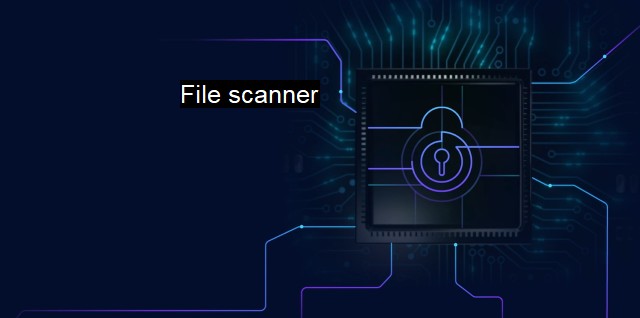What is File scanner?
Defending your System: Understanding the Function and Importance of File Scanner in Cybersecurity and Antivirus"
A file scanner is a vital component of any security software that enables the detection, prevention, and removal of malicious programs. These programs, known as malware, often mask as regular files and circulate on the internet, chiefly through email attachments, malicious websites, downloads, and portable storage devices.Their main role is to identify abnormal patterns or behaviors that can potentially harm computers and devices. They can also affirmatively recognize digital signatures, like fingerprints, of known malwares. Thus, file scanners provide a critical primary line of defense by ensuring all incoming files are devoid of any destructive elements.
File scanners are fueled by advanced algorithms, which are based on an up-to-earth database of existing risk elements. They leverage certain mutual characteristics of these hazards such as hexadecimal identifiers' patterns, file structure anomalies, specific traces, or resource manipulations that can be unfavorable to the user's computer or data. They can be manually triggered to scan a specific file or grouped set of files or can be scheduled to regularly conduct routes on the complete system.
To the less technological apt, one thing to visualize a file scanner is similar to a daily security guard walking around every corner of a prestigious hotel scanning for any suspect signs of criminal activity. On another level the scopes stretch far beyond our imagination since they incessantly evolve to outpace the advancement of threats.
A smart file scanner never ceases hunting malware. Consider that in today's cyber world objects like files, folders, emails are akin to our postal system. It inevitably comes bundled with unwanted and dangerous elements. By scanning scrips, images, executables, attachments, and downloads while they transit into your system. Therefore, file scanners intercept possible threats right at our ‘digital post offices.’
Given this complexity, file scanners function on various operational depths. The basic desperado scanner works on readily available binaries' surface signatures, i.e., they examine the code as it enters the system. On the other hand, with features like root-kit detection, real-time monitoring, proactive threat view, and machine learning modules, advanced scanners can even monitor your system right down to RAM usage, kernel familiarity, and network traffic patterns.
This semi-intuitive layer is crucial since some malware spawn and mutate within a system undetected by entry controls shielding hackers from being identifiable. Scanning files for deeper structural constitutions can also reveal clues about parent-child associations of different files, stagnated residing of red flagged files, and shadow copies.
A couple of genuine challenges emerge in enforcing good file scanner utility. In this advanced digital era, a phishing ploy can come from anywhere at any time. Firstly, maintaining efficiency is important. The faster these scans are, the less disruption they cause to the user. Techniques such as load balancing, hashing queues, intelligent allocation, differential scanning, and prefetch priming are opportunities ripe for evolution. Faster, lighter, and wider should be the mantra for the next-generation file scanner.
File scanners are mostly cloud-driven these days, consolidating global threat landscapes on to a common learning module. Such generic immunity adapts itself across millions of devices, learning in real time about new threats and sharing insights across networked devices, making scanning faster, lighter and more penetrative.
File scanners not only police malicious file entry but also play a grander orchestration role, as they coordinate with firewalls, intrusion detectors, antivirus software, log analyzer, attack vector analyzer, sandboxes and data spill prevention measures. They are not a one-stop solution but rather a critical link in a vast plethora of tools that underpin our digital safety.
Recognizing their quintessential function, necessary precautions have to optimize file scanners. Regular updating regime, allowing full access permissions, maintaining zero-trust practices, adopting a broad coverage across all asset categories, and establishing a strong ‘system repair and fortress rebuilding’ module on scanner detection, keep the digital gate machines running.
Thus, seen from any perspective, a file scanner represents the first and fundamental stride towards keeping the pervasive spread of malicious cyber activities at bay. It carries an enormous weight where the always-on nature of networks, the ever-growing depth of connectivity, and the increasing sophistication of cyber threats intersect. As the modern world continues to digitalize and our virtual existence becomes more rampant, the significance of tools like file scanners can only exponentially grow more crucial.

File scanner FAQs
What is a file scanner?
A file scanner is a cybersecurity tool that scans files for malicious content, viruses, and other potential threats.What does a file scanner do?
A file scanner analyzes files and compares them against a database of known malware signatures and behaviors to identify any potentially harmful content.How does a file scanner protect against cyber threats?
A file scanner helps protect against cyber threats by identifying and removing any malicious content from files before they can infect a system or network.Is a file scanner necessary for antivirus protection?
Yes, a file scanner is an integral component of antivirus protection, as it provides a critical layer of defense against malware and other cyber threats that may otherwise go undetected.| | A | | | B | | | C | | | D | | | E | | | F | | | G | | | H | | | I | | | J | | | K | | | L | | | M | |
| | N | | | O | | | P | | | Q | | | R | | | S | | | T | | | U | | | V | | | W | | | X | | | Y | | | Z | |
| | 1 | | | 2 | | | 3 | | | 4 | | | 7 | | | 8 | | |||||||